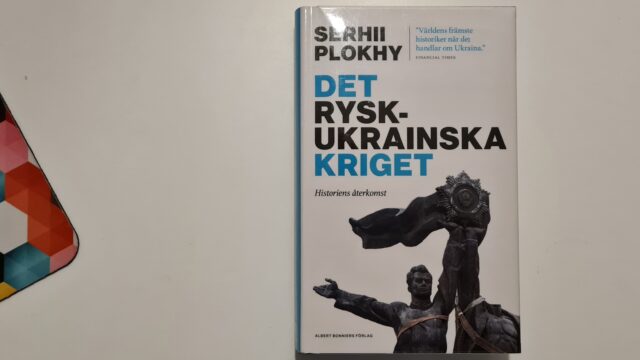I’ve reviewed The Gates of Europe: A History of Ukraine before – a completely outstanding book about Ukraine, author being historian Serhii Plokhy. This is the second book of him I review, a very contemporary, and initially, personal account of The Russo-Ukrainian War, beginning a few days prior to the full-scale invasion and war.
I truly appreciate Plokhy introducing the reader to a very brief and coherent history of Ukraine, before continuing to the actual war itself. Initially, Plokhy gives us a personal account of the very beginning of the full-scale war initiated by Russia on the 24th of Februari 2022. As a reader, I can feel his anxiety and connection to the nation assaulted by a larger, dangerous and ruthless neighbour.
Plokhy provides us with Ukrainian and Russian sources, and therefore accounts of what Vladimir Putin actually did say, or might have said, on certain occasions, which puts things into perspective. The infamous televised meetings, publications, and public speeches and debates are briefly mentioned here, giving us a precious insight into the Russian debate on which nations are perceived to belong to the Russian nation (or empire, if you will): Belarus, Kazakstan, Estonia, Latvia, Lithuania, Ukraine, Georgia, Moldavia. Perhaps Armenia and Azerbaijan. This facilitates, for instance, the comprehension of recent Russian threats and discourse on armed nuclear attacks on European capitals.
The book provides historical insights, and retrospect accounts of Ukraine’s position in the Soviet Union, the aftermath of the Cold War and the beginning of the 2000’s, with the Orange Revolution, EuroMaidan and first invasion of 2014-2015 at its focus. All this, puts the war into a context and provides the reader with a coherent comprehension of what has happened prior to the war beginning last war and why Ukraine is attacked by Russia.
In between, Plokhy depicts the invasion, the initial Ukrainian reaction, the responses of the Ukrainian Armed Forces and president Volodomyr Zelensky, and the population. Then, the Russian onslaught on Kiev, Butja, Charkiv and Mariupol take centrepiece.
The relationship between China and USA are later discussed, and this is one of the best parts of the book. I’ve spent an entire semester studying China and have read a lot about US history, presidents and political system, and might claim I’ve got a fairly good perception of what’s happening in the Pacific Ocean, as well as between the countries. Plokhy’s account of the tension, but also dynamo, between these two titans is very relevant to this war, China being able to use Russia for its own purposes, while being an uncomfortably ally, and the US taking a fierce stance against Russia, while not wanting to completely antagonising its perceived and dedicated main rival.
Plokhy can, in other words, really put things into perspective, and for this I’m grateful. Considering the stress and time-pressure this book was written, it’s impressive.
Three downsides of the book from a needy reader
There’s several maps in the introduction to the book. The absence of maps in the chapters is one downside, since a lack of visual, detailed maps next to the text turns the reading experience into a constant page-turning event, if one is prone to check the whereabouts of an event. This becomes almost a confusing experience during the chapter explaining the Ukrainian offensives towards Cherson and near Charkiv. Is the town of Izium in Cherson oblast, or in or close to Charkiv oblast? Is Mykolaiv close to Cherson or Charkiv? If you’re familiar with the maps from the Institute for the Study of War you might know, but if not, you’re usually lost.
Another downside is the assertive focus on the Ukrainian side. Don’t get me wrong, I strongly support Ukraine and want them with borders restored to pre-2014 and the dignity of the nation-state of Ukraine restored. I want the civilians to be able to live their lives without Russian interference. And I want peace for Ukraine, on their own terms.
However, that doesn’t mean the book should focus so much on Russia’s losses and troubles on the front. I’ve listened to, and read texts, Ukrainian troops describing how they loose people in trenches and foxholes, for instance last summer during heavy and intense Russian artillery fire, or soldiers entering a forest and losing approximately 75 % of the soldiers in a very short time. Reading the book you wrongly get the picture of only Russia suffering heavy losses, which has been far from the case. Unfortunately.
Thirdly, I’d include the lack of gender perspective, but this is only because I’m a very needy reader. Plokhy is a very (I need to stress very) competent writer and historian. But during this war I really feel the absence of gender perspective. This winter Lisa Bjurwald released Slava Ukraini! Womens resistance to Russia’s War. It deals with women’s resistance against Russia, the systemic repression, rapes and violations against women perpetrated by Russia’s armed forces, the Ukrainian women’s part of the armed forces, civilian and volunteer forces and importance for the nation of Ukraine. It’s bleak and very dark on the one hand, but also positive, good and hopeful. This recognition of specifically women is hard to come by in wars, although I also lack, generally, the real understanding and insights of men being sacrificed by superiors on the fron.
All in all
So far, this might be the only book that compresses the first year of the war in a reliable and proper way.
